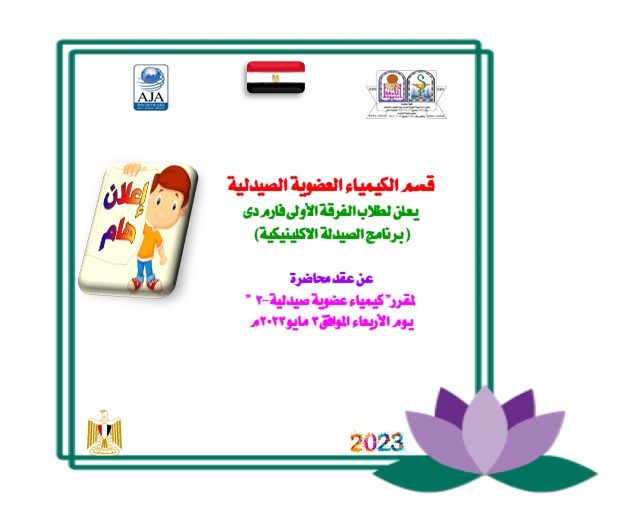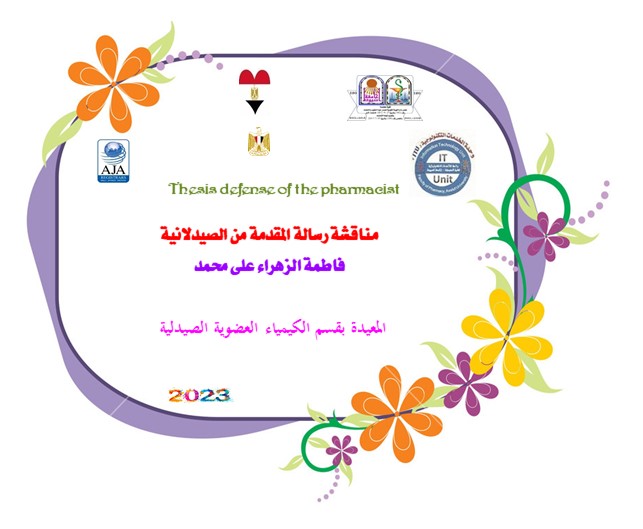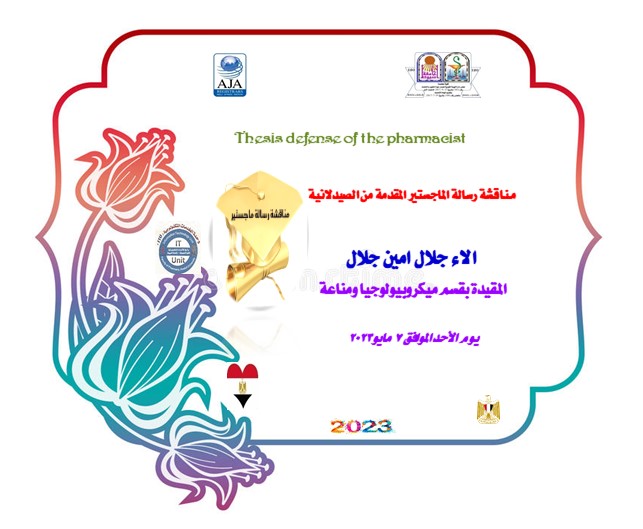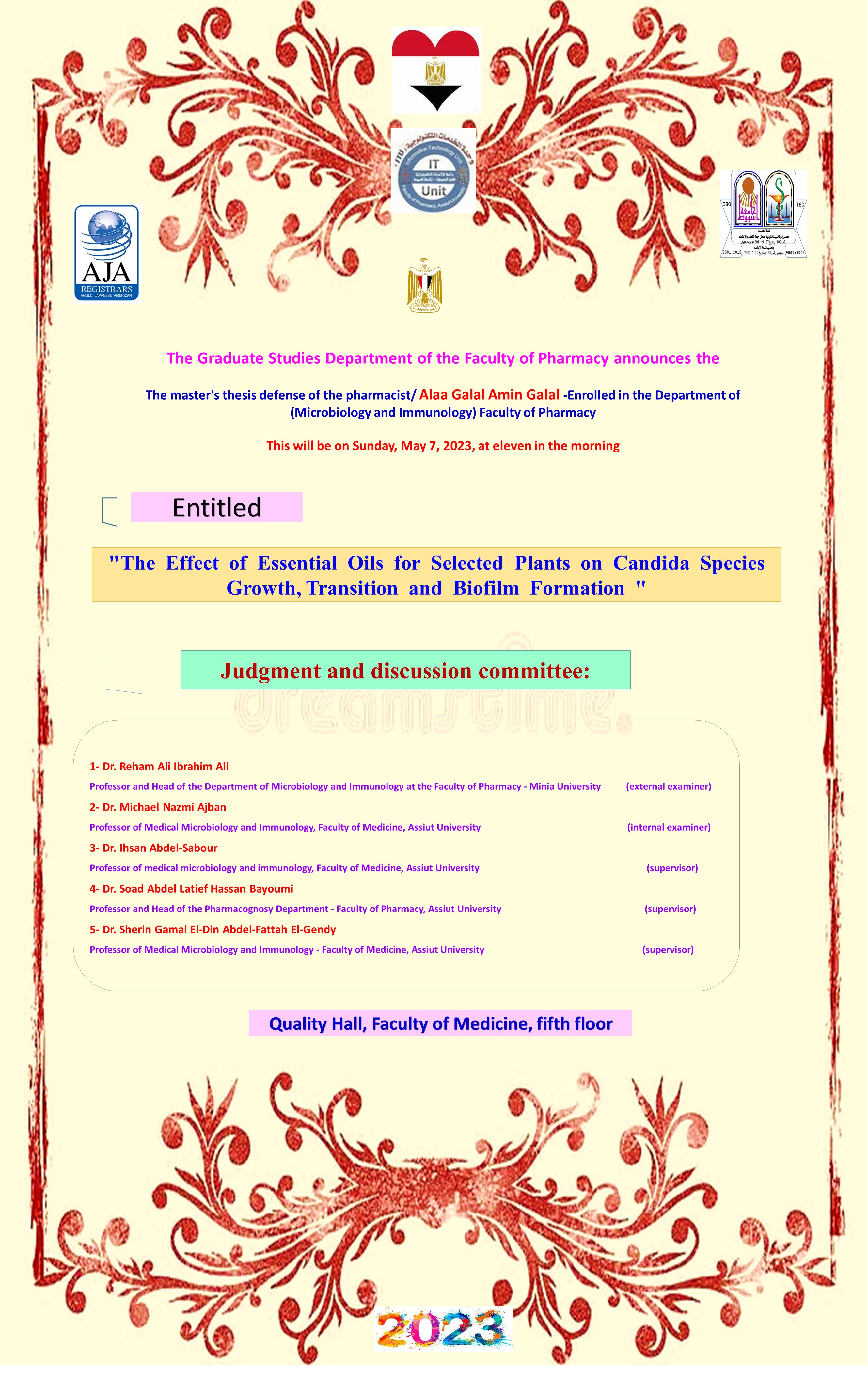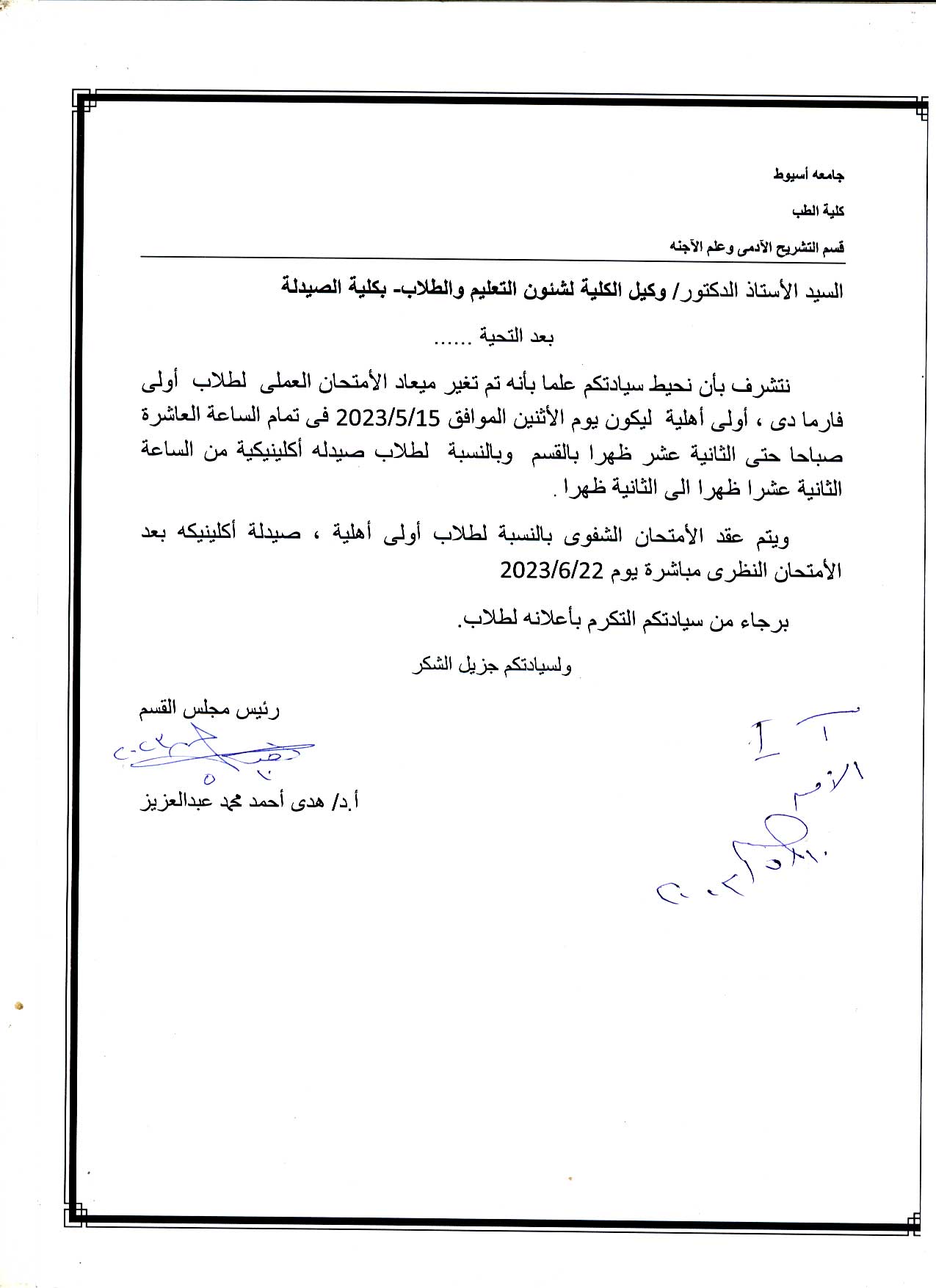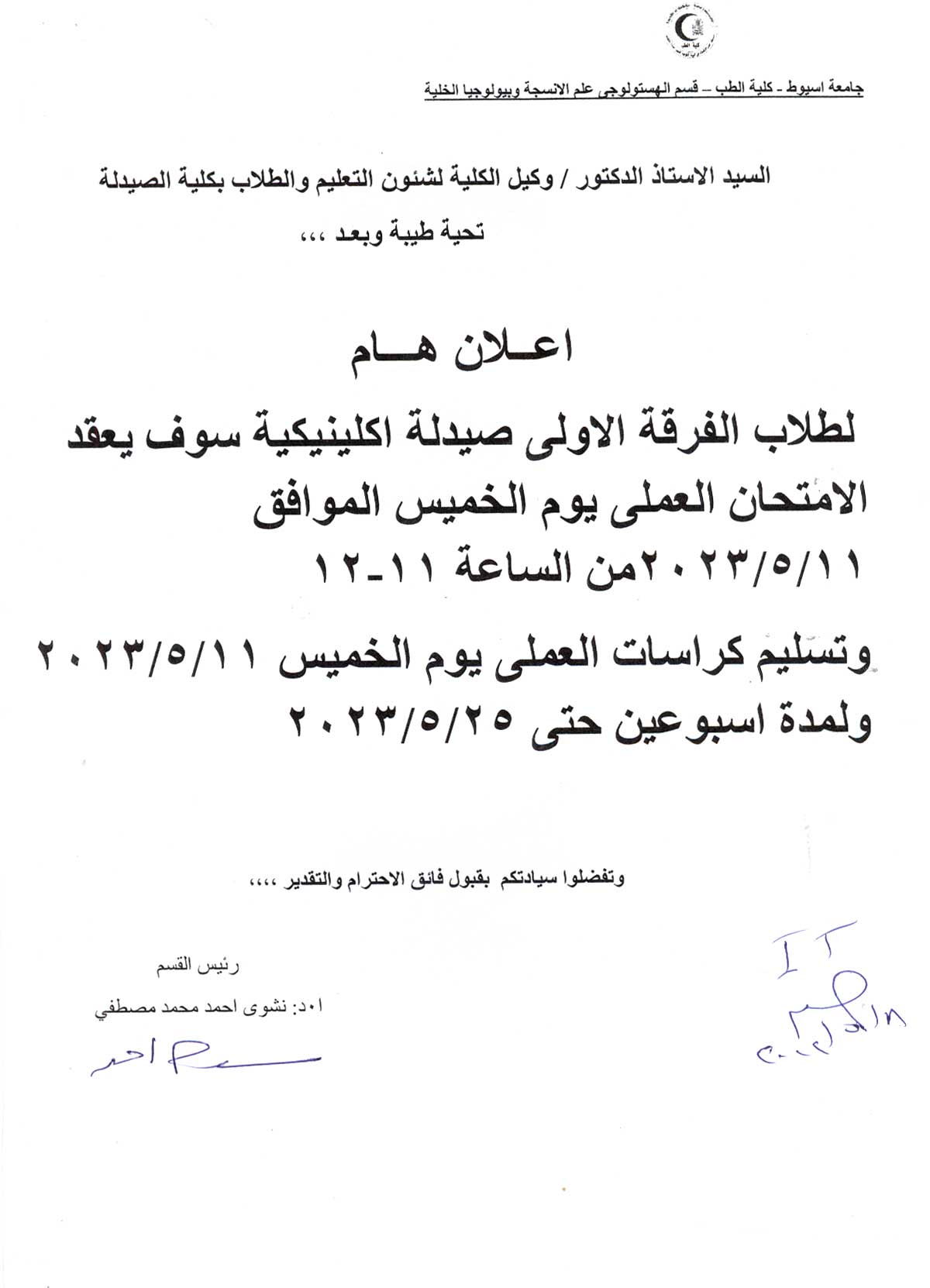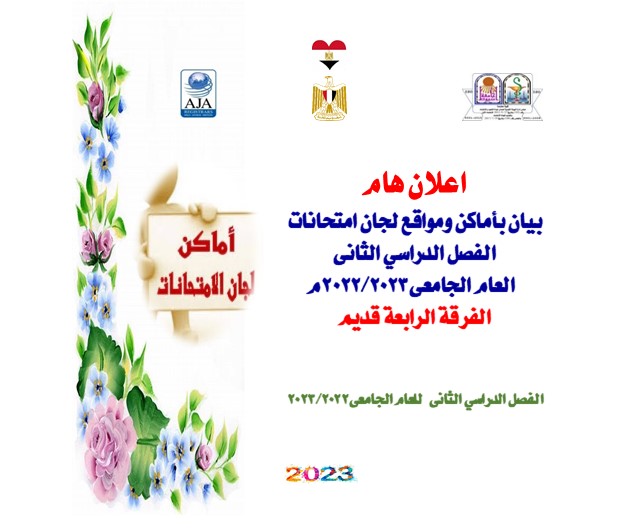

 Do you have any questions? (088) 2080369 - 2345622 Pharmacy_QAAU@pharm.aun.edu.eg
Do you have any questions? (088) 2080369 - 2345622 Pharmacy_QAAU@pharm.aun.edu.eg
The master's thesis defense by the pharmacist/ Fatma Al-Zahraa Ali Muhammad - Teaching Assistant in the Department of Pharmaceutical Organic Chemistry - on Tuesday, May 9, 2023
The master's thesis defense by pharmacist/ Alaa Galal Amin Galal - registered in the Department of Microbiology and Immunology - on Sunday, May 7, 2023
The Department of Human Anatomy and Embryology (Faculty of Medicine) announces to the students of the first year Pharm D, the first year Al-Ahlia University, and the students of the Clinical Pharmacy program that a practical exam will be held on Monday
The Department of Histology, Histology and Cell Biology (Faculty of Medicine) announces to students of the first year of clinical pharmacy that a practical exam will be held on Thursday, May 11, 2023
Dual Targeting of Steroid Sulfatase and 17β-Hydroxysteroid Dehydrogenase Type 1 by a Novel Drug-Prodrug Approach: A Potential Therapeutic Option for the Treatment of Endometriosis
A novel approach for the dual inhibition of steroid sulfatase (STS) and 17β-hydroxysteroid dehydrogenase type 1(17β HSD1) by a single drug was explored, starting from in-house 17β HSD1 inhibitors via masking their phenolic OH group with a sulfamate ester. The sulfamates were intentionally designed as drugs for the inhibition of STS and, at the same time, prodrugs for 17β-HSD1 inhibition (“drug-prodrug approach”). The most promising sulfamates 13, 16, 18–20, 22–24, 36, and 37 showed nanomolar IC50 values for STS inhibition in a cellular assay and their corresponding phenols displayed potent 17β-HSD1 inhibition in cell-free and cellular assays, high selectivity over 17β-HSD2, reasonable metabolic stability, and low estrogen receptor α affinity. A close relationship was found between the liberation of the phenolic compound by sulfamate hydrolysis and 17β-HSD1 inactivation. These results showed that the envisaged drug-prodrug concept was successfully implemented. The novel compounds constitute a promising class of therapeutics for the treatment of endometriosis and other estrogen-dependent diseases.
A feasible HPTLC method for concurrent quantitation of allopurinol-montelukast co-therapy in plasma and evaluation of their hepatic and renal effects in rats: Analytical, biochemical, and histopathological study
Recent studies presented the crucial role of montelukast (MON, a leukotriene receptor antagonist) against gouty arthritis and its protective effect on drug-induced liver and kidney injury. Allopurinol (ALO, a selective xanthine oxidase inhibitor) is also used for treatment of hyperuricemia, however, it induces hepatotoxicity and acute kidney injury. Therefore, this study introduces the first analytical/biochemical/histopathological assay for MON-ALO co-therapy and aims to: inspect the hepatic and renal impacts of ALO, MON and their combination in rats via biochemical and histopathological examinations, propose and validate a facile HPTLC method for concurrent estimation of ALO-MON binary mixture in human plasma, and employ this method to attain the targeted drugs in real rat plasma. First, the cited drugs in human plasma were simultaneously separated utilizing silica gel G 60 F254-TLC plates. The separated bands were scanned at 268 nm demonstrating appropriate linearities (50.0–2000.0 ng band−1 for each drug) and correlations (0.9986 and 0.9992 for ALO and MON, correspondingly). The calculated detection and quantitation limits, as well as recoveries confirmed the method’s reliability. This procedure was validated, and the stability studies were achieved according to Bioanalytical Method Validation Guideline. This work was extended to investigate the possible hepatic and renal effects of ALO, MON and their co-therapy in rats. Using rat’s gastric tube, the following was administered to four groups of male Wistar rats: Group Ia and Ib as control (received either saline or DMSO), Groups II, III, and IV were given MON, ALO, and MON+ALO, respectively. Good correlation between the measured biochemical parameters and the observed histopathological changes was encountered. Considerable drop in aspartate transaminase and alanine transaminase levels, in addition to lower liver damage changes were observed in the combination group compared to MON or ALO-treated groups. Regarding renal changes, ALO-MON co-therapy caused elevation in the serum creatinine and blood urea nitrogen levels when compared to controls and MON- or ALO-treated groups. Severe proteinaceous casts accumulation in kidney tubular lumen, severe congestion, and severe tubular necrosis were also noticed in the combination group. Lastly, this study suggests ALO-MON co-treatment not only as a preventive therapy against gouty arthritis but also as a new line to minimize ALO-induced hepatic injury. However, co-administration of ALO and MON should be further studied to assess the benefits and risks in various tissues, adjust the MON dosing, and monitor its nephrotoxic effect.
The locations the examination committees for the second semester of the academic year 2022-2023 for the old Fourth year
A meeting of the laboratories and scientific equipment committee at the Faculty of Pharmacy on Wednesday, May 10, 2023
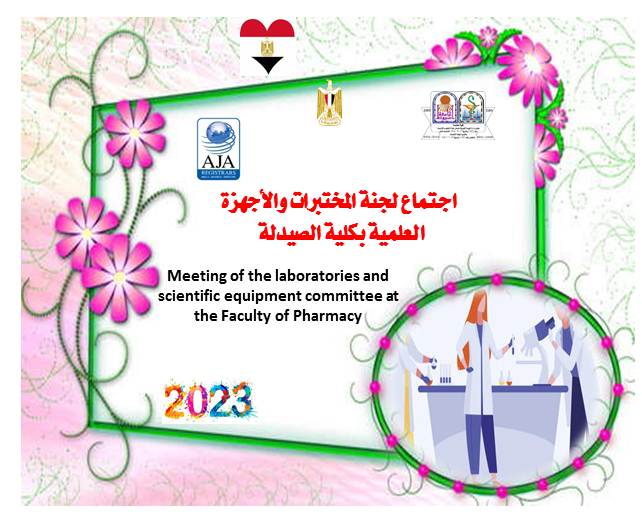
God willing, the laboratories and scientific equipment committee will hold its meeting on Wednesday, May 10, 2023 at eleven (AM)
in the office of Vice Dean for Community Services and Environmental Development Affairs.
Meeting of the committee for community and environmental development at the Faculty of Pharmacy on Wednesday, May 10, 2023

God willing, A meeting of the committee for community and environmental development will hold on Tuesday, April 11, 2023 at 10:00 AM on Wednesday, May 10, 2023
In the office of Vice Dean for Community Services and Environmental Development Affairs.


